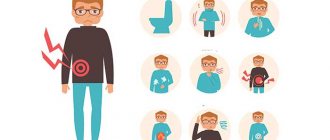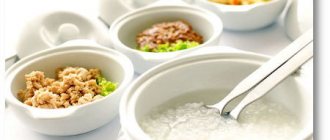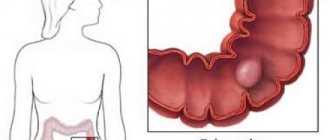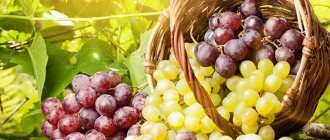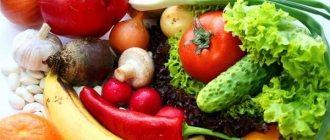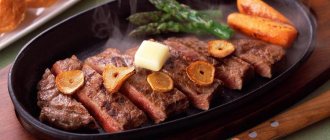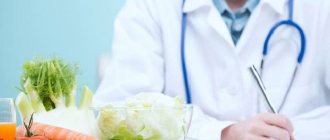General rules
Resection of the stomach or part of it in a number of cases is the only possible method of treating and saving the patient’s life. Stomach surgery is a radical method of treating extensive malignant neoplasms ( stomach cancer ), stomach ulcers , polyps, and gastric bleeding that are not amenable to conservative treatment. Despite the progress of medicine, gastric removal remains one of the most difficult surgical operations, and even if it is successful and there are no significant complications, rehabilitation takes a long period of time, and nutrition after gastric surgery is the most important component of this process.
Diet after gastrectomy or after removal of part of the stomach
Parenteral nutrition after gastrectomy begins with Diets No. 0A , 0B , 0B ( 1A , 1B , 1B surgical) prescribed sequentially. Their intended purpose is to provide the patient’s body with a minimum amount of basic food nutrients, unload and spare the stomach, and prevent intestinal bloating and flatulence . The diet contains easily digestible foods containing complete proteins, fats, carbohydrates, vitamins and macro/microelements and an increased amount of free fluid. Salt consumption is sharply limited.
On the first postoperative day, the patient is shown to be hungry; on day 2 - the diet includes 250 ml of warm sweet tea and rosehip infusion (50 ml), which are given after 15-20 minutes in a teaspoon; on days 4-5, in the absence of abdominal bloating and normal peristalsis, Diet No. 0A and 2 soft-boiled eggs are prescribed; on days 6-8 Diet No. 0B ; on days 9-11 - Diet No. 0B .
- Diet No. 0A . Contains 5-10 g of proteins, 15-20 g of fats and 180-200 g of carbohydrates. The volume of free liquid is 1.8-2.2 l, sodium chloride is no more than 1-2 g. The energy value of the daily diet varies between 760-1020 Kcal. Food is served in liquid form. Fractional diet - up to 7-8 times a day and the amount of food per meal is no more than 250 g. The diet includes mucous decoctions with cream, light low-fat meat broth, fruit and berry jelly/jelly, sweet rosehip decoction, fruit and berry juices . Dishes with a pureed and dense consistency, drinks containing carbon dioxide, and whole milk are completely prohibited.
- Diet No. 0B . Contains 40-50 g of protein, 50 g of fat and 250 g of carbohydrates. The volume of free liquid is up to 2 l/day, sodium chloride is no more than 4-5 g. The energy value of the daily diet is 1580-1650 Kcal. Food is prepared in liquid/puree form. Diet - up to 6 times a day, portion size should not exceed 400 g. In addition to the permitted products of Diet No. 0A , the diet is expanded by adding mucous cereal soups cooked in vegetable broth, soft-boiled eggs, liquid pureed rice and buckwheat porridges cereals, protein steamed omelettes, pureed dietary meat and fish, sweet berry jelly.
- Diet 0B . It is a diet of a transitional stage to subsequent physiologically complete nutrition. Contains 80-90 g of protein, 70 g of fat and 320 g of carbohydrates. The volume of free fluid is 1.5 l/day. Sodium chloride no more than 6-7 g. The energy value of the daily diet is 2100-2400 Kcal. Food is served in puree form. Diet: 5-6 times a day. The diet additionally includes cream/mashed soups, pureed steamed meat and fish, pureed cottage cheese with cream, fermented milk drinks, baked apples, pureed fruit/vegetable puree and 50-75 g of white crackers.
The duration of each surgical diet is 2-4 days, but, if necessary, the time spent on them can be lengthened or shortened. That is, approximately, after 9-12 days, the surgical diet after the operation ends, and the patient is transferred to the standard Diet No. 1 according to Pevzner (mashed version), which limits the amount of food consumed at one time: no more than 250 g of the first pureed dish or a glass of liquid (250 g), and for lunch - only two dishes. Meals are fractional, 5-6 times a day.
The diet contains an increased amount of protein (100-110 g), which includes dishes from boiled minced meat, boiled fish, fresh mashed/calcined cottage cheese, and egg white omelettes. The amount of fat in the diet is at the level of physiological norms or several times higher (80-90 g). If the patient does not tolerate fats well (and in their pure form too), which is manifested by bitterness in the mouth, regurgitation, diarrhea, their quantity is limited to 60-70 g. The carbohydrate content is reduced to 300-320 g due to easily digestible carbohydrates.
In some cases, in particular with dumping syndrome , manifested by dizziness , weakness, palpitations , chills, a feeling of heat, abdominal pain and bloating, diarrhea that appears after eating, it is necessary to completely eliminate foods containing sugar, since the consumption of easily digestible carbohydrates is one of the reasons for its appearance.
To slow down the evacuation of food from the gastric stump, it is recommended to consume viscous and jelly-like foods. You can practice separate meals of dense and liquid consistency, starting with dense ones, as well as eating in a lying position. Eat food in even small portions 6-7 times a day. After eating, you need to lie/recline in bed for 30-40 minutes. You can also practice eating butter before eating carbohydrate foods, which inhibits the removal of food from the gastric stump. If whole milk is poorly tolerated, it is excluded from the diet and replaced with other products.
Strong broths based on meat, mushrooms and fish, fatty red meat and fish, some types of birds (duck, goose) and products based on them (sausages, canned food, ham, smoked meats), fried foods, dough products are completely excluded from the diet. , fresh bread, savory snacks, salted fish and vegetables, solid animal fats, undiluted raw vegetables and fruits.
If the patient feels well, 3-4 months after the operation, he is gradually transferred to the unprocessed version of Diet No. 1 . The diet is physiologically complete, contains an increased amount of proteins and an almost normal amount of fats and complex carbohydrates. The restriction applies to simple carbohydrates in order to prevent the development of dumping syndrome. Culinary methods of processing products are preserved: the products are boiled or steamed, and after boiling, baked or stewed. In terms of the range of products, the diet of this diet option is more extensive, but the rules and restrictions are the same.
It is allowed to eat low-fat meat soups, borscht, cabbage soup (once a week), dried wheat bread, low-fat fish and beef, chicken dishes, and savory cookies. It is allowed to eat boiled and raw vegetables, garden herbs, fermented milk products, dishes based on buckwheat and rice, potatoes, mild low-fat cheese, dietary varieties of sausages, fresh fruits and berries.
In the absence of complications and satisfactory gastrointestinal function, 6 months after surgery, the patient can switch to a normal diet, but taking into account the diet and the characteristics of the chemical composition of the diet. It is possible to independently adjust the set of food products in the diet, taking into account individually intolerant foods. With a significant loss of body weight (by 10-15%) after gastrectomy, especially for cancer, the calorie content of the daily diet should be increased compared to the physiological norm by increasing the content of basic nutritional nutrients recommended for the diet.
peptic ulcer occur, a pureed version of Diet No. 1 , and in case of exacerbation - sequentially No. 1A and 1B with changes made to them taking into account intolerance to certain foods. In general, the nutrition of patients with diseases of the operated stomach must be individualized.
It is advisable to include specially developed dietary nutritional mixtures in the diet after gastric surgery - “ Nutrizon ”, “ Nutridrink ”, “ Berlamin Modular ”, which should be administered in small portions, possibly diluted with water, with constant assessment of their tolerability.
Dietary nutrition must necessarily include taking vitamin-mineral complex tablets, drugs that normalize the motor-evacuation function of various parts of the gastrointestinal tract and drugs containing enzymes to improve digestion processes ( Creon , Mezim-Forte ). Complete rehabilitation of patients is long-term and usually occurs by the end of the first year after surgery.
Authorized Products
The diet after gastrectomy when transferring the patient to Diet No. 1 ( A , B ) includes mucous cereal soups from rice, buckwheat, oatmeal with the addition of butter, low-fat cream or egg-milk mixture, cream to the finished dish. For second courses, lean types of red meat are used (veal, beef), chicken or turkey, well boiled and minced.
Dishes of white fish (cod, pollock, pike, hake) in the form of steamed or boiled are allowed. Cereal dishes are prepared with milk/water in the form of liquid porridge from buckwheat, oatmeal, and rice, to which butter is added.
If tolerated well, the diet includes milk and dishes based on it, low-fat cream, calcined cottage cheese, milk jelly, chicken eggs in the form of a steam omelet or soft-boiled.
Among fats, preference is given to butter and vegetable oils, added immediately before use to the finished dish. Jelly and jelly made from sweet berries are healthy. Drinks include juices from fresh berries, weak tea with cream, rosehip infusion.
Table of permitted products
| Proteins, g | Fats, g | Carbohydrates, g | Calories, kcal | |
| buckwheat (kernel) | 12,6 | 3,3 | 62,1 | 313 |
| cereals | 11,9 | 7,2 | 69,3 | 366 |
| white rice | 6,7 | 0,7 | 78,9 | 344 |
| white bread crackers | 11,2 | 1,4 | 72,2 | 331 |
| sugar | 0,0 | 0,0 | 99,7 | 398 |
| milk | 3,2 | 3,6 | 4,8 | 64 |
| cream | 2,8 | 20,0 | 3,7 | 205 |
| cottage cheese | 17,2 | 5,0 | 1,8 | 121 |
| boiled beef | 25,8 | 16,8 | 0,0 | 254 |
| boiled veal | 30,7 | 0,9 | 0,0 | 131 |
| rabbit | 21,0 | 8,0 | 0,0 | 156 |
| boiled chicken | 25,2 | 7,4 | 0,0 | 170 |
| turkey | 19,2 | 0,7 | 0,0 | 84 |
| chicken eggs | 12,7 | 10,9 | 0,7 | 157 |
| butter | 0,5 | 82,5 | 0,8 | 748 |
| mineral water | 0,0 | 0,0 | 0,0 | — |
| black tea with milk and sugar | 0,7 | 0,8 | 8,2 | 43 |
| juice | 0,3 | 0,1 | 9,2 | 40 |
| jelly | 0,2 | 0,0 | 16,7 | 68 |
| rose hip juice | 0,1 | 0,0 | 17,6 | 70 |
| * data is per 100 g of product | ||||
Puree diet
A special diet, which the patient must follow in the first months after surgery, helps reduce inflammation and develop recovery processes in the stomach. All dishes are prepared by steaming or using water. They wipe it down. Preference is given to protein foods. The diet provides for a significant restriction of simple carbohydrates, salt and liquid taken with food
The diet includes:
- pureed vegetable soups (except cabbage) with cereal broths,
- low-fat broth,
- chicken,
- dishes from lean beef and fish (cod, pike perch, carp, pike) in chopped form,
- soft-boiled eggs or steam omelet,
- milk as part of dishes or whole milk (as tolerated).
It is better to use sour cream only as a seasoning; you can start drinking kefir one and a half to two months after the operation.
Vegetables are allowed: boiled cauliflower, stewed zucchini and pumpkin, potatoes and carrots - in the form of puree.
You can make casseroles (without sugar) or viscous porridges from cereals and pasta. It is better not to use semolina for these purposes.
Vegetable oil and butter are used as seasoning for ready-made dishes.
You can eat mild grated cheese.
It is better to prepare jelly and mousse from fruits. Fruit juices are allowed (except grape juice, since it causes excess gas in the intestines), as well as unsweetened tea.
The following foods are excluded from the diet:
- baking,
- liver,
- kidneys,
- lung,
- pickles and smoked meats,
- canned food,
- sausages,
- chocolate and cocoa,
- jam,
- mushrooms,
- legumes,
- onion and garlic,
- White cabbage,
- spinach,
- sorrel,
- radish,
- coffee,
- carbonated drinks and ice cream.
It should be remembered that sweet milk porridges, as well as sweet hot milk and sweet tea are among the products that provoke the manifestation of dumping syndrome, and therefore it is better to exclude them.
The volume of food taken and the range of dishes should be expanded gradually. The first two weeks after surgery, portions should be small. The amount of liquid at one time cannot exceed 200 ml.
Depending on the general condition of the patient, after about 2-4 months it is possible to switch to an unprocessed diet.
Fully or partially limited products
The patient's diet after gastric surgery excludes bakery and confectionery products, fresh bread, pastries, and products made from any type of dough. Strong broths based on meat or fish, dishes made from fatty meats and fish, as well as products based on them (canned food, sausages, smoked meats), solid animal and cooking fats, fried foods, pickles, mushrooms, various snacks, vegetables and raw fruits, full-fat cottage cheese, cheese, sour cream, fermented milk products.
You cannot include various sauces, seasonings, and spices in your diet. The consumption of carbonated drinks, strong tea, coffee, concentrated vegetable and fruit juices, and any alcohol-containing drinks is prohibited.
Table of prohibited products
| Proteins, g | Fats, g | Carbohydrates, g | Calories, kcal | |
Vegetables and greens | ||||
| vegetables | 2,5 | 0,3 | 7,0 | 35 |
| vegetables legumes | 9,1 | 1,6 | 27,0 | 168 |
| swede | 1,2 | 0,1 | 7,7 | 37 |
| cabbage | 1,8 | 0,1 | 4,7 | 27 |
| green onion | 1,3 | 0,0 | 4,6 | 19 |
| bulb onions | 1,4 | 0,0 | 10,4 | 41 |
| white radish | 1,4 | 0,0 | 4,1 | 21 |
| horseradish | 3,2 | 0,4 | 10,5 | 56 |
| spinach | 2,9 | 0,3 | 2,0 | 22 |
| sorrel | 1,5 | 0,3 | 2,9 | 19 |
Mushrooms | ||||
| mushrooms | 3,5 | 2,0 | 2,5 | 30 |
Cereals and porridges | ||||
| corn grits | 8,3 | 1,2 | 75,0 | 337 |
| pearl barley | 9,3 | 1,1 | 73,7 | 320 |
| millet cereal | 11,5 | 3,3 | 69,3 | 348 |
| barley grits | 10,4 | 1,3 | 66,3 | 324 |
Flour and pasta | ||||
| pasta | 10,4 | 1,1 | 69,7 | 337 |
Bakery products | ||||
| bagels | 16,0 | 1,0 | 70,0 | 336 |
| wheat bread | 8,1 | 1,0 | 48,8 | 242 |
Confectionery | ||||
| jam | 0,3 | 0,2 | 63,0 | 263 |
| candies | 4,3 | 19,8 | 67,5 | 453 |
| pastry cream | 0,2 | 26,0 | 16,5 | 300 |
Ice cream | ||||
| ice cream | 3,7 | 6,9 | 22,1 | 189 |
Cakes | ||||
| cake | 4,4 | 23,4 | 45,2 | 407 |
Chocolate | ||||
| chocolate | 5,4 | 35,3 | 56,5 | 544 |
Raw materials and seasonings | ||||
| mustard | 5,7 | 6,4 | 22,0 | 162 |
| ginger | 1,8 | 0,8 | 15,8 | 80 |
| ketchup | 1,8 | 1,0 | 22,2 | 93 |
| mayonnaise | 2,4 | 67,0 | 3,9 | 627 |
| ground black pepper | 10,4 | 3,3 | 38,7 | 251 |
| chilli | 2,0 | 0,2 | 9,5 | 40 |
Dairy | ||||
| sour cream | 2,8 | 20,0 | 3,2 | 206 |
Meat products | ||||
| pork | 16,0 | 21,6 | 0,0 | 259 |
| salo | 2,4 | 89,0 | 0,0 | 797 |
Sausages | ||||
| dry-cured sausage | 24,1 | 38,3 | 1,0 | 455 |
| sausages | 12,3 | 25,3 | 0,0 | 277 |
Bird | ||||
| smoked chicken | 27,5 | 8,2 | 0,0 | 184 |
| duck | 16,5 | 61,2 | 0,0 | 346 |
| smoked duck | 19,0 | 28,4 | 0,0 | 337 |
| goose | 16,1 | 33,3 | 0,0 | 364 |
Fish and seafood | ||||
| dried fish | 17,5 | 4,6 | 0,0 | 139 |
| smoked fish | 26,8 | 9,9 | 0,0 | 196 |
| canned fish | 17,5 | 2,0 | 0,0 | 88 |
Oils and fats | ||||
| creamy margarine | 0,5 | 82,0 | 0,0 | 745 |
| animal fat | 0,0 | 99,7 | 0,0 | 897 |
| cooking fat | 0,0 | 99,7 | 0,0 | 897 |
Alcoholic drinks | ||||
| white dessert wine 16% | 0,5 | 0,0 | 16,0 | 153 |
| vodka | 0,0 | 0,0 | 0,1 | 235 |
| cognac | 0,0 | 0,0 | 0,1 | 239 |
| beer | 0,3 | 0,0 | 4,6 | 42 |
Non-alcoholic drinks | ||||
| cola | 0,0 | 0,0 | 10,4 | 42 |
| sprite | 0,1 | 0,0 | 7,0 | 29 |
| tonic | 0,0 | 0,0 | 8,3 | 34 |
| black tea | 20,0 | 5,1 | 6,9 | 152 |
| energy drink | 0,0 | 0,0 | 11,3 | 45 |
| * data is per 100 g of product | ||||
Nutrition menu after gastrectomy (Diet)
The menu for the week after gastrectomy should ensure the alternation of various protein and cereal dishes in order to prevent monotony, while strictly observing the permitted methods of culinary processing of products and, most importantly, observing the portion sizes. It must be remembered that meat/fish dishes can be consumed in the form of puree or soufflé once a day. If you are intolerant to milk, it must be replaced with other products or consumed in small portions, as well as diluted with weak tea.
What to eat after surgery?
Nutrition after removal of a polyp or part of the stomach should be selected as gentle as possible. On the first day after surgery, you can fast if recommended by your doctor. Considering that after the surgeon’s intervention in the stomach, the stomach’s ability to digest food is slightly impaired, incompletely digested food fragments will penetrate into the intestines, which will bring discomfort in the stomach, nausea, and other negative manifestations. To minimize unpleasant symptoms, you need to eat very small portions and limit fluid intake to 200 ml at a time.
Nutrition after surgery should be structured so that the amount of protein foods and vitamins is increased. But the use of salt and the consumption of carbohydrate-containing foods should be reduced to a minimum. As we have already said, you need to eat often (at least 6 times a day), but in small portions. Gastric resection is a serious procedure to remove part of the stomach, which involves intervention in the human body. Before the procedure, careful preparation is required, and after the procedure, a special postoperative regimen is required.
The main indication for such an intervention is stomach cancer and other malignant tumors that are not amenable to more humane treatment. After gastric resection, the patient’s life changes dramatically. Because of this, special nutrition after removal of the stomach for cancer is an integral part of the patient’s life.
After resection, food will move through the digestive tract faster than before, so patients often complain of a feeling of heaviness. The following may also sometimes appear:
- Dizziness.
- General fatigue.
- Drowsiness.
- Dumping syndrome, etc.
Patients who cannot do without resection must be prepared for the fact that after the procedure changes in the functioning of the pancreas and small intestine will be noticed, as a result - weight loss, hypovitaminosis, anemia, and other negative consequences. In some cases, patients, especially if resection does not allow success, are prescribed a more effective operation - complete removal of the stomach. But such a radical procedure also has its own characteristics and negative consequences, and mortality in the early stages of the postoperative period is about 10-12%.
Reviews and results
Properly organized nutrition after gastric resection is an essential component of the rehabilitation process, and the timing of recovery and the course of the postoperative period largely depend on its proper organization and compliance. Reviews from most patients emphasize the importance of proper nutrition after gastric surgery.
- “... They operated on me for gastric bleeding after a sharp autumn exacerbation of a peptic ulcer. Of course, they immediately put me on a diet. At first I was scared to eat, because I was afraid that the bleeding might resume. But after 15 days I was transferred to Table 1B, 1B, and then to the first table, where I stayed for almost 8 months. After recovery, I still try to stick to my diet and quit drinking alcohol and smoking. As the surgeon told me, diet is now your doctor and everything depends on your attitude to nutrition”;
- “... I regret that I didn’t take diet seriously before, although every year I suffered from severe exacerbations of peptic ulcers, and now, after undergoing surgery for a perforated ulcer, I try to eat right. True, when going to work, following a diet is not easy and not very convenient, but I had to learn how to cook and take everything I needed with me to work, since there is still no alternative, and now I’m afraid to eat like everyone else from a common table.”
Nutrition after a few months
During gastric resection for cancer, restoration of the functioning of the gastrointestinal tract takes a long time, so nutrition should remain dietary even several months after the operation. The patient must continue to follow the principles of diet No. 1, but can already eat food in pieces. It is preferable to prepare dishes by boiling, stewing and baking.
6-8 months after gastrectomy, the patient’s menu may be the same as everyone else’s. However, it is very important not to forget about the regime - you need to eat little and often. In addition, a person who has undergone stomach cancer and such a complex operation should not risk his health and eat junk food, much less drink alcohol.
